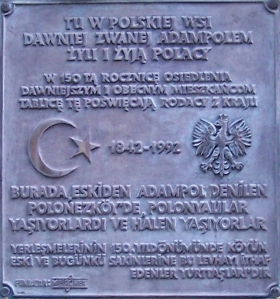
Few people know that the Ottoman Empire (now Turkey) was the only major power to not recognise the Polish partitions and final dissolution of the state of Poland in 1795. What is more, Constantinople (now Istanbul) was the only capital city in the world to retain a Polish ambassador throughout the 123-year period during which Poland literally disappeared off the face of the map.

With these conditions in place, it made it easy for a Polish community to be set up in the Ottoman Empire. After the failure of Poland’s November Uprising in 1831 against the Russian Empire, a group of Poles decided to escape to the generally pro-Polish and anti-Russian lands of the Ottoman Empire. It is at this point the wonderful story of the establishment of a Polish settlement in the Ottoman Empire (Turkey) begins. The village of Adampol (then known as Adamköy in Turkish, ‘the village of Adam’) was founded in 1842 by, and named after, Prince Adam Czartoryski, the head of the Polish National Uprising Government. The initial plan was to make Adamköy Poland’s most important emigration and expatriate hub after Paris. The plan was an ambitious one and was soon implemented by Czartoryski.

Prince Czartoryski dispatched his aide Michał Czajkowski (who later converted to Islam and became Mehmet Sadık Paşa) to Turkey. He purchased a large forested area on which Adamköy was founded. It was initially settled by only a handful of people but quickly swelled after the end of the Crimean War and with emigrants from Siberia. Adamköy-Adampol’s population seemed relatively stable for a period of years. Following the end of the first World War and the re-establishment of Poland, however, many of its inhabitants decided to ‘return’ to Poland.

One might even claim that Adampol, now known as Polonezköy (Turkish ‘Polish village’) is a ‘Polish-themed’ village. Even though only one third of Polonezköy’s inhabitants are of Polish descent and of its 1,000 inhabitants only 40 people speak Polish, the head of the village is traditionally chosen from amongst the Polish community of Polonezköy. Unlike the ‘lost Polish tribe of Haiti’ (mentioned in a previous post), Polonezköy still retains a Polish flavour and due to its unique character has had the honour of hosting a variety of distinguished guests including Turkey’s national hero and President Atatürk (in 1937), the future Pope John XXIII (in 1941), Turkish President Kenan Evren as well as Polish Presidents Lech Wałęsa and Aleksander Kwaśniewski.
Thanks for the post. Very interesting. I had never heard about the Lost Polish tribe, and will pass on the link to my friends.
Glad you like it, John. 🙂
Great post Raf. I knew of Poles’ efforts in Turkey to organize forces to fight alongside the Turks (Mickiewicz and others), but not about Adampol. Turkey had been both an enemy and an ally of Poland throughout the ages, but it treated us better than most of our neighbours.
It seems Poland was more an ally than an enemy and there seems to be warm feeling still according to my sources.
Great post, Raf. Cheers!
Poland was in a long series of wars against the Ottoman Empire until the 18th century when it appeared that defeating our common enemies wasn’t such a good idea. Then we became best friends.
Why do you call Prince Adam a Duke?
* Of course I meant defeating Turkey and strengthening our common enemies.
Thanks for the ‘Duke’ uwaga – I’ve changed it. 😉
Some of us are pedantic, aren’t we?
I tend to be very pedantic, but this time I was really asking.
There’s no difference between Duke and Prince in Polish. Both are “książę”, but everytime I see an English translation of Czartoryski’s works he’s called “Prince”.
On the other hand all the “Polish Princes” were not Polish. In Czartoryski’s case his title meant his rights to the Grand Duchy of Lithuania. So Duke?
Confusing, you see…
Very confusing, indeed. A similar situation is with the Polish word ‘pałac’. Some of them are hardly palaces, more country houses but that’s the gorgeousness of translation.
By the way, please join me on my new site:
http://uzar.mekabima.com/
Good post. I like it.
Polska dziękuje!
THE PARTITIONS of the Polish-Lithuanian Commonwealth in the second half of the eighteenth century opened a new chapter in the history of mutual contact. Modern Polish historiography maintains the narrative that the Ottoman Empire was the only state that did not recognize the final partition of Poland-Lithuania in 1795 by its neighbouring states: Russia, Prussia and Austria. One of Mustafa Kemal’s colleagues during the War of Independence, Ali Fuat Cebesoy related to Michał Sokolnicki, Polish Ambassador to Ankara in the years 1936-45, an anecdote that is still repeated in Poland. Whenever the diplomatic corps was received at the court of the Sublime Porte, the chef de protocol is said to have asked ‘Where is the deputy from Lehistan?’, and at each occasion he would receive the same reply from an aide, ‘Your Excellency, the deputy of Lehistan could not make it because of vital impediments’ to the annoyance of the deputies of the partitioning states. The partition and disappearance of the Polish-Lithuanian Commonwealth in 1795 and the subsequent strengthening of its neighbours, especially Russia, did not go unnoticed in the Ottoman Empire. The catastrophic fate of the northern neighbour was perceived by key Ottoman statesmen as a warning and a definite sign of the urgent need for reform of the Ottoman state – See more at: http://poloniaottomanica.blogspot.ca/p/overview-of-polishottoman-history.html#sthash.MMpmnOPT.dpuf